Introduction
- Rational choice theory suggests that consideration of mutual interest is most beneficial when discussing strategic choices with outcome dependent on negotiation.
- Socio-psychological patterns cause irrational human behavior.
- Maximum utility may differ based on context and perception of fairness.
- Therefore, morality overlaps strategically optimal economic behavior.
- Thesis: This paper presents an experimental ultimatum game that seeks to investigate the behavioral economics of fundamental bargaining and rational maximization.
The ultimatum game represents the clash of human rationality and morality. It highlights that people choose to act fairly or punish those who choose an unjust approach, despite what theoretically should be an optimal economic behavior – selecting the choice that results in the most significant profit. The game shows the difficulty of modeling human rationality in economics. It has also been cited as evidence against a common assumption that participation in capitalism must result in greed or selfishness.
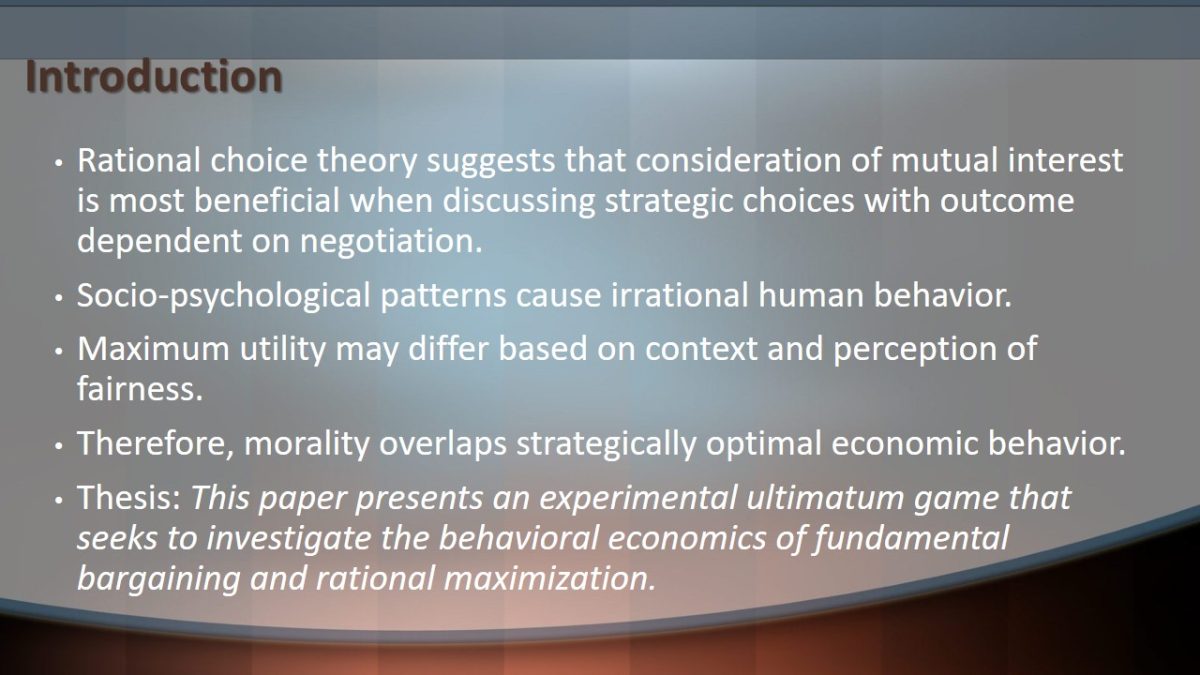
Literature Review
- The ultimatum game is based on game theory, which suggests that choice in human interactions is dependent on the behavior of the other participant.
- The game studies response to incentives is that of the perspective of self-interest by analyzing the distribution of resources providing a highest possible return (“The Ultimatum Game”).
- Numerous studies have shown that at least half of recipients decline offers that are below 30% of the original value, consistent with gender, culture, and social factors (Bland et al. 2).
- Offers vary from 26% to 57% with an average proposal in the range of 40-50% of the original value (Schuster 2).
- Social preference rationalizes rejection of offers. Since there is no consumption to justify financial gain, participants value social components more highly (Zürn and Strack 2).
- Such behavior is not necessarily irrational; it can be argued to be strategically rational through motivation of establishing fairness or self-interest to punish the other player (Brañas-Garza et al. 2).
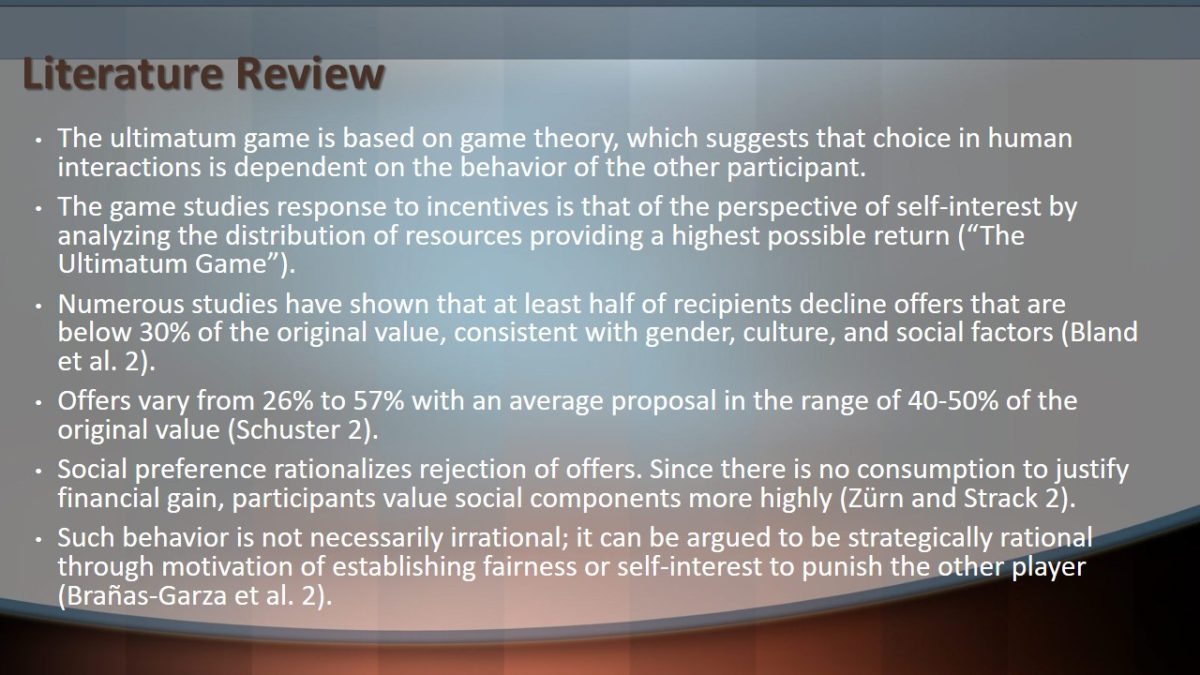
Design
- A strategic bargaining scenario between two players.
- A fixed amount is given to the proposer which the players must split between themselves.
- The proposer must make an offer to the responder that will result in a maximized payoff.
- The responder has the choice of accepting or rejecting the offer.
- If the offer is accepted, both players receive the specified amount. If rejected, both players receive no payoff.
The design is meant to be simple in order to isolate the specific behavior of bargaining. However, it is usually not played for more than one round between a pair of players in order to eliminate reciprocation. The purpose remains to make an offer which would be accepted. Therefore, the game shows that guided by the threat of punishment (financial loss), most people will act in a manner that is seemingly fair.
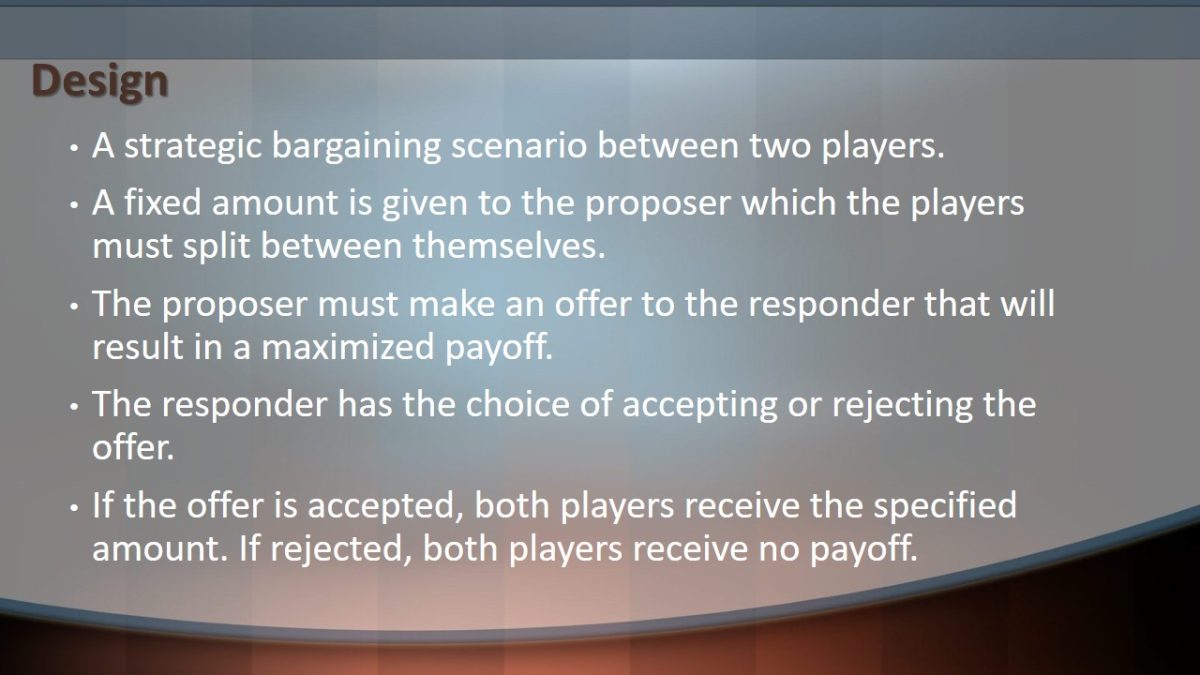
Equilibrium
- The ultimatum game is both sequential (one player moves after the other) and asymmetric (differing sets of strategy).
- The fraction the proposer wants to keep is denoted by x, then the offer is 1-x and p is the average offer.
- The subgame Nash equilibrium for this game tree is at 9,1 since the “offer p, accept p and reject every lower offer” with p>10% is not subgame-perfect and rejecting an offer of 1 would not be a rational choice by the responder.
- The idea of a golden ratio expressed as x-(1-x)=1-x results in x=2/3. In terms of monetary value, while many researchers have called 50/50 a fair split, the most efficient and justified ratio is 4,6 (Schuster 2).
The image shows all possible variants of moves and outcomes using extensive form.
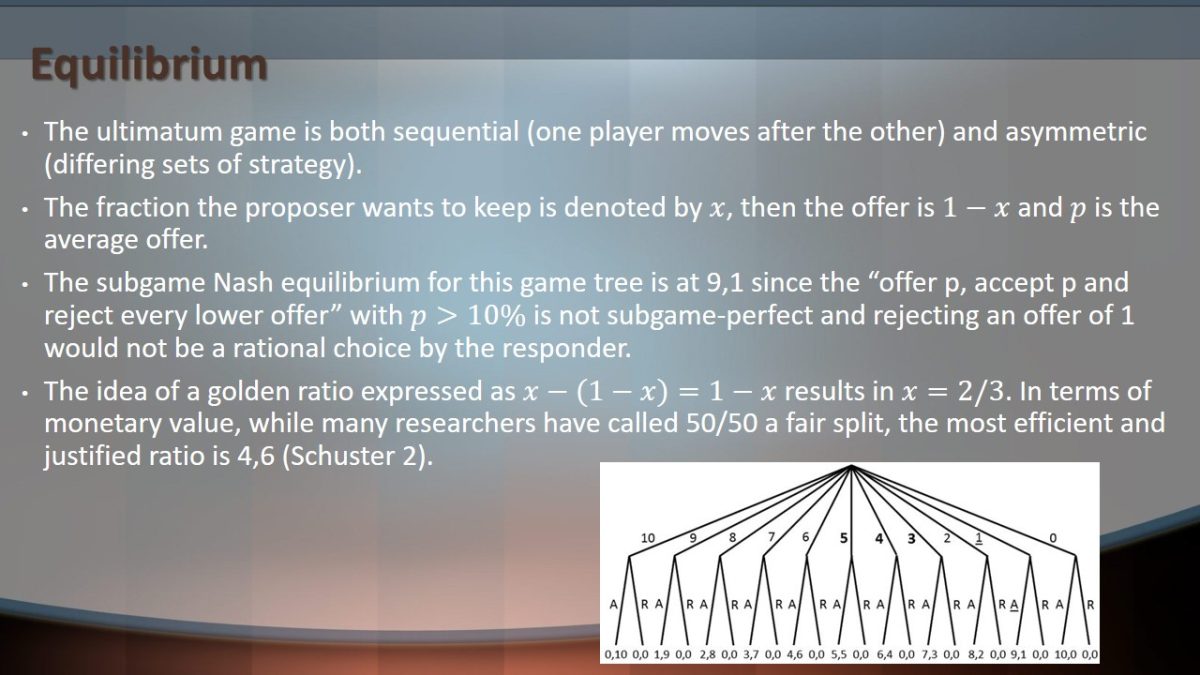
Hypothesis
- In an unmodified ultimatum game, participants will deviate from the Nash Equilibrium and maximized utility strategy by choosing to accept offers higher or equal to the golden ratio of 2/3.
- This takes into account previous research and mathematical analysis using the golden ratio.
- The Nash Equilibrium of (1,9) in favor of the proposer will most likely be rejected due to unfairness despite it being a rational choice based on economic theory.
The hypothesis highlights the importance of comparing traditional economic theory with the necessity to more accurately model human behavior. Both fairness and altruism are social mechanisms that affect the most logical decision-making processes. The ultimatum game essentially becomes a study about the presence of fairness rather than its absence. The proposer must be able to infer the respondent’s conception of fairness versus material gain.
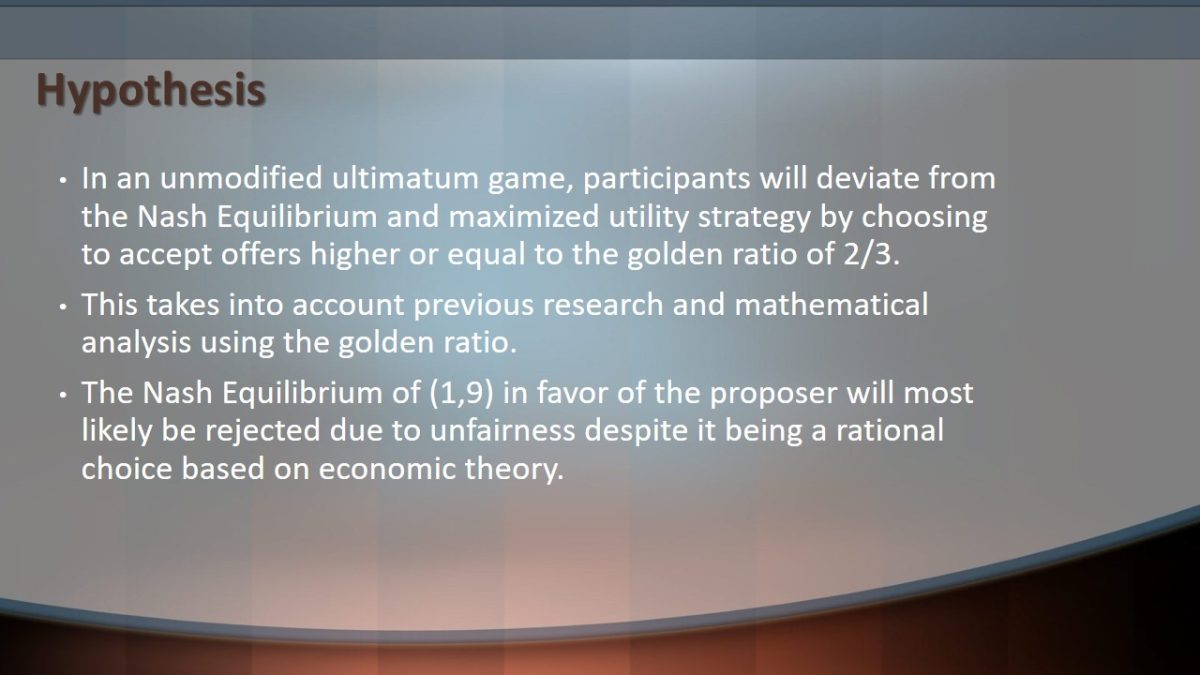
Procedures
- Conducted in a classroom setting, takes approximately 20 minutes.
- Students are randomly assigned a number to determine proposers and responders.
- The experimental format ensures anonymity.
- Proposers must fill out a form making an offer based on a $10 value.
- Respondents are then randomly given the forms which they must fill out with acceptance or rejection of the offer.
- Collected data is analyzed for offer and rejection frequencies which can be graphed or used to conduct regression analysis.
- Student numbers can be used to collect demographic information.
Although this economic game does not necessarily require anonymity, it is helpful to eliminate social pressures. Students should be provided with a clear explanation of the game rules as well as theoretical concepts at some point during the lesson.
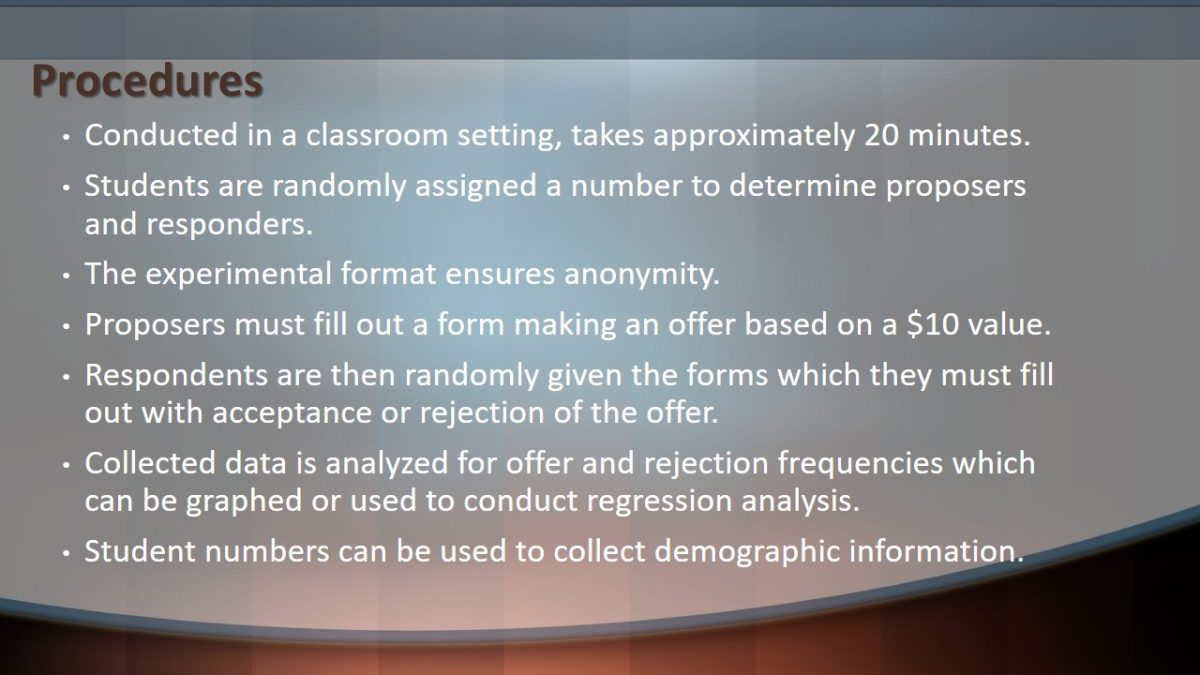
Works Cited
Bland, Amy, et al. “Cooperative Behavior in the Ultimatum Game and Prisoner’s Dilemma Depends on Players’ Contributions.” Frontiers in Psychology, vol. 8, 2017, pp. 1-11. Web.
Brañas-Garza, Pablo, et al. “Fair and Unfair Punishers Coexist in the Ultimatum Game.” Scientific Reports, vol. 4, 2014, pp. 1-4. Web.
Schuster, Stefan. “A New Solution Concept for the Ultimatum Game Leading to the Golden Ratio.” Scientific Reports, vol. 7, 2017, pp. 1-11. Web.
“The Ultimatum Game.” Foundation for Teaching Economics, n.d. Web.
Zürn, Michael, and Fritz Strack. “When More Is Better – Consumption Priming Decreases Responders’ Rejections in the Ultimatum Game.” Frontiers in Psychology, vol. 8, 2017, pp. 1-9. Web.